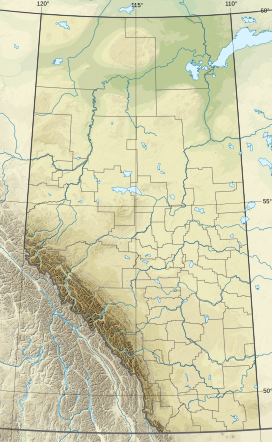East End of Rundle
| East End of Rundle (EEOR) | |
|---|---|
 East End of Rundle and Whitemans Pond seen from the Ha Ling Trail. | |
| Highest point | |
| Elevation | 2,590 m (8,500 ft)[1] |
| Coordinates | 51°04′50″N 115°25′19″W / 51.08056°N 115.42194°W[2] |
| Geography | |
 | |
| Interactive map of East End of Rundle | |
| Country | Canada |
| Province | Alberta |
| Parent range | South Banff Ranges, Canadian Rockies |
| Topo map | NTS 82O3 Canmore[1] |
| Climbing | |
| Easiest route | easy/moderate scramble[1] |
East End of Rundle (EEOR) is a mountain located immediately west of the town of Canmore, Alberta and immediately west of the Spray Lakes road in the Canadian Rockies. Mount Rundle occupies the space between Canmore and Banff on the southwest side of the Trans-Canada Highway.
There is a scrambling route up from the Spray Lakes road.[1]
Geology
[edit]The mountain is composed of sedimentary rock laid down during the Precambrian to Jurassic periods.[3] Formed in shallow seas, this sedimentary rock was pushed east and over the top of younger rock during the Laramide orogeny.[4]
Climate
[edit]Based on the Köppen climate classification, the mountain is located in a subarctic climate with cold, snowy winters, and mild summers.[5] Temperatures can drop below −20 °C with wind chill factors below −30 °C. Precipitation runoff from Rundle drains into the Bow River which is a tributary of the Saskatchewan River.
Gallery
[edit]See also
[edit]References
[edit]- ^ a b c d Kane, Alan (1999). "East End of Rundle". Scrambles in the Canadian Rockies. Calgary: Rocky Mountain Books. p. 73. ISBN 0-921102-67-4.
- ^ "East End of Rundle". Peakbagger.com. Retrieved 2019-09-15.
- ^ Belyea, Helen R. (1960). The Story of the Mountains in Banff National Park (PDF). parkscanadahistory.com (Report). Ottawa: Geological Survey of Canada. Archived (PDF) from the original on 2015-10-02. Retrieved 2019-09-13.
- ^ Gadd, Ben (2008). Geology of the Rocky Mountains and Columbias.
- ^ Peel, M. C.; Finlayson, B. L. & McMahon, T. A. (2007). "Updated world map of the Köppen−Geiger climate classification". Hydrol. Earth Syst. Sci. 11: 1633–1644. ISSN 1027-5606.
External links
[edit]- Scramble description from www.scrambling.ca
- "East End of Rundle". Peakware.com. Archived from the original on 2016-03-04.





